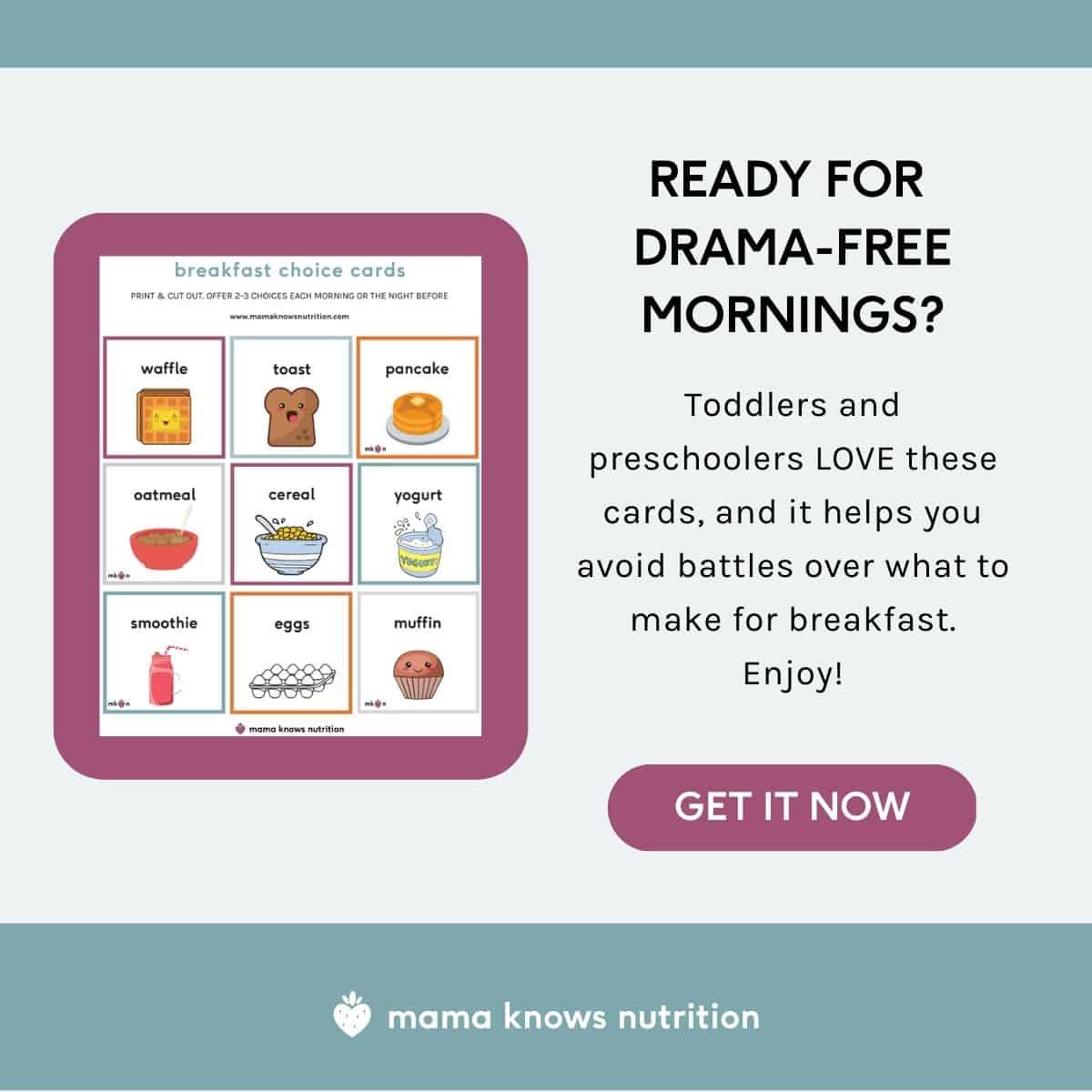
Menu
When your kid picks up the meal you lovingly served them and throws it directly onto your freshly cleaned rug WHILE maintaining eye contact…I bet the last word you’d use to describe your mood is gentle. Same goes for the nights they refuse to eat anything. And the times they don’t touch dinner…but have the nerve to request a snack before they even leave the table!

You might think you’ve been too easy on them. That you need to be tougher. Or that maybe your parents are right and you SHOULD force them to eat what’s in front of them. But those approaches don’t feel good for your kids. And they definitely don’t feel good for you.
You know what does, though? Gentle parenting at mealtimes! It might sound passive and soft, but I promise, it’s not! It’s all about holding loving boundaries. And it’s the best way to get your kids to eat enough food happily and consistently without the power struggles.
Yes! Gentle parenting is great for kids. There’s tons of research to back that up. But it has to be true gentle parenting.
There’s this misconception that gentle parenting is “soft”—the kind of parenting where you give into your kid’s every demand and desire and raise them to believe they’re the most special snowflake that ever snowflaked. But that’s not gentle parenting at all—it’s something called “permissive” parenting. And unless you’re okay with being your kid’s servant for life, it’s not the way to go!
True gentle parenting (AKA “authoritative parenting” or “love with limits”) isn’t about being excessively nice or accommodating. It’s a collaborative approach that helps kids understand that their caregivers are on their team—not their staff! It puts a big emphasis on empathy, understanding, respect, AND boundaries. So you’re still super warm and loving…but you’re also confidently holding boundaries that as a parent, you know will keep your child healthy and safe while teaching them skills they’ll need to thrive.
Can we just pause here and acknowledge how HARD that is to do? Gentle parenting is not easy or passive at all! So if you’re working on gentle parenting and it feels hard, that’s because it is. But it’s also super worth it. It’s not a fool-proof approach for perfect behavior, but it is a strategy aimed at building long-term trust and respect and fostering healthy relationships.
Okay, so now that we’re on the same page, let’s work through some examples of how to use gentle parenting at mealtimes!

First of all, if once and a while giving them the plate they want is an easy solve, great! Do that. It’s definitely not the end of the world. But CONSTANT meltdowns about what plate or cup or bowl or fork they’re given can lead to power struggles, which can make you feel like you need to “put your foot down.” When this happens, you’re miserable, your kid is miserable…everyone becomes dysregulated! And that’s hard to come back from at mealtimes.
I know it’s tempting to use logic and say, “It doesn’t matter what color the plate is! They all hold food!” but when’s the last time your toddler was like, “You know what, mom? You’re right! I’m being totally illogical right now! Pass me that red plate.” I’m guessing never!
The gentle parenting way to handle this would be to acknowledge that whether we agree or not, for some reason, the blue plate is important to your little one right now—while holding the boundary that you’re not willing to re-plate their meal for no reason. You can hold that boundary firmly and kindly, even if it upsets your child.
“You want to eat off the blue plate. I hear you. You don’t want the red plate tonight. The blue plate is in the dishwasher right now, but let’s plan to have breakfast on the blue plate tomorrow!”
For older kids, it sometimes helps to add, “I’ll make a note that you want to have breakfast on the blue plate.” It may feel silly but it shows your child that you understand and heard them. You could even write down the note on a post-it to show them it’s important to you, too.
Both examples go a long way in helping your child feel like you’re on the same team, and that they have some control over their life.
Having a voice and a choice is SUPER important to kids. So while we can’t let them choose everything all the time, we can let them make small choices daily to make them feel more in control. Before your next mealtime, you could say,
Giving them SOME say in what’s going on can go a long way in preventing mealtime struggles.
When your child HATES what you made, wants something else, or takes one bite and spits it out yelling that they wanted GRILLED CHEESE instead…I know it can be SO frustrating. It probably makes you want to impose rules or say something like, “Too bad, this is what’s for dinner!” or just give in and make them a grilled cheese. But those aren’t your only options. Instead, hold your boundary of “this is what’s on the menu tonight,” but offer a chance to connect and collaborate, too. And steer clear of minimizing or dismissing their emotions. Even if you’re pretty sure they’re exaggerating or they’re being unreasonable.
“I agree, grilled cheese sounds delicious! Let’s look at the calendar and pencil it in for later this week!” This way, they learn that you heard them in their frustration and want to find a solution that includes their desires.
Remember: it’s not your job to cook their favorite meal every night! Your job is to make sure there is at least one safe food on the plate. Their job is to choose what to put in their bodies.
This is similar to the picky eating philosophy we teach. You don’t have to make them another meal in the moment. If you’re worried they’re truly not getting enough at a meal, maybe add 2 safe foods on the plate or offer a glass of milk or a (very boring) bedtime snack.
Plan 1-2 nights each week where your child’s favorite meal will be served. If you have a toddler who loves chicken fingers and mac and cheese, you could tell them, “Tonight it’s YOUR dinner night! I want to make something you LOVE. Do you want chicken fingers or mac and cheese?” And if your child is older, you can ask for their input: “Hey, I’m planning out meals for the week. Wednesday night is your choice. What sounds good?”

Whether they claim they’re not hungry, they ate too many snacks, or they’re seemingly on a hunger strike, they are NOT eating. And you’re worried they’re not getting enough nutrition.
This is actually really common at dinnertime because toddlers and kids are known to front-load their food early in the day and then only graze by dinnertime. Also, parental pressure is usually at an all-time high at night because we want to make sure they’ve had enough for the day with bedtime approaching. (If this is you, friendly reminder that bedtime snacks are a-okay.)
I know it’s tempting to tell your child how much they have to eat, insist they try all the things or urge them to eat more. But that approach never really feels good, right? For them or you. In this case, a gentle parenting approach aligns perfectly with something called ‘division of responsibility’ in feeding.
The Division of Responsibility, coined by Ellyn Satter, states that at mealtimes, parents and kids have distinct responsibilities.
As the parent, your responsibility is to decide:
Your child’s responsibility is to decide:
This approach respects your child’s autonomy and teaches them to listen to their body. Sometimes they truly aren’t hungry and that’s okay. We can’t determine what is “enough” for them—they have to do that part themselves. Fostering your child’s ability to check in with and follow their own body cues is the best way for them to build that skill and truly get enough of what they need each day.
I’m not saying to let them go hungry, either. But if you provide safe food on the plate for them, you’ve done your job. It’s their job to decide what goes in their bodies. Plus, if they don’t eat at mealtime, you can always offer a bedtime snack later. Just try to avoid making them a totally separate meal.
I know that in practice, this “Division of Responsibility” thing can feel much trickier than it sounds. You’re likely to stress when your child isn’t eating “enough.” But if you let it, the Division of Responsibility can take a lot of the burden off of you at mealtime! When you don’t feel so pressured, you’ll be able to relax. And that will take some pressure off your kids, too.
If your child says they’re not hungry, try saying something like “Let’s check in with our body! How is your tummy feeling? Is it full?” This helps teach them to connect the dots between the food they eat and how full they feel. Download my teddy bear hunger and fullness guide to help teach your child to understand and communicate their fullness!

This one can’t really be prevented! If you’re not hungry, you don’t usually want to eat, and the same is true for kids. But, we can help this become less of an issue by focusing on regular mealtimes and limiting snacks to reasonable times throughout the day (AKA not grazing all day).
Prepare your child by explaining that your family aims for 3 meals and 2 snacks throughout the day, then give them a heads up on when these things will happen. “We’re going to have an after-school snack when we get home! What would you like?” This brings them into the conversation and can make them feel like they have some agency. And when they know what to expect, they may be able to align their hunger cues with your mealtimes over time.
This one can be so frustrating! You work your tail off at mealtime to make a nutritious plate…but they won’t touch it because they’re always filling up on snacks between meals. And of course, the snacks they want are the ones with less nutritional value (looking at you, goldfish!). ALSO because they won’t eat their meal, they never really get full. So your job of being a human snack dispenser never ends. It’s a whole thing.
“We’ll have a snack this morning before we go to the store, and we’ll have lunch when we get back.” It’s okay to hold the boundary of not snacking all day.
Setting reliable food expectations can go a long way here. Tell your child that snacks are offered at designated times (read: not all day long). Over time, this helps them understand what to expect.
One thing I recommend against is kids having a self-serve snack drawer. Kids can’t rationalize that dinner is in 45 minutes, and having access to snacks that are fun, convenient, and tasty will always be more appealing to them. This isn’t to say we need to make ALL food off-limits between meals—food isn’t contraband and we don’t want them to feel like it is! But young kids need help regulating their schedules, so providing unrestricted access to snacks is usually counterproductive.
This one goes hand in hand with your child not wanting to eat. Whether they don’t want to eat AT ALL or they don’t eat as much as you want them to…if the cards aren’t played right, a power struggle is likely to ensue. Here’s what to do:
Be really mindful about asking them to meet arbitrary food limits because what that does is ask them to override their body’s cues. And if they’re going to have a good relationship with food for life, they need to hear those cues!
I know how frustrating this is—truly, I have lived this multiple times. I also know your intentions are so good and you just want to make sure they get enough. But when you think they should eat 3 bites of vegetables but all they want is 1 bite…forcing them to eat more invites the power struggle AND diminishes their autonomy. You might get a “win” in the moment but long-term, it’s a lose-lose. Instead, try to breathe, go to Tahiti in your mind, and allow them to stop when they say they’re full. Then pat yourself on the back for the herculean feat you just accomplished!
See Related: Picky toddler only wants to eat ONE food at a meal
Practice getting comfortable saying, “Okay, you don’t have to eat it!”
This might seem like giving them an ‘out’ which can be rage-inducing after you worked so hard to plan out, shop for, and prepare their food…but it’s so important for several reasons:

This one is pretty unavoidable! Sometimes kids just flat out do not like certain foods. In particular, the green ones. Here are some things you can say to get ahead of the power struggles, though:
It’s also okay to reinforce the boundary and let them know not to expect backup food later.
Another strategy to get them more interested in the food they don’t want to eat is to play with the food! Have them pick it up, smell it, or lick it. Mention how the broccoli looks like a small tree or show them how you can hold the bell pepper slice out in between your teeth. Anything that keeps them engaged is great, even if they’re not eating it yet!
Making food a fun experience will keep the pressure low and makes trying new foods more inviting. Even if they don’t actually taste it until further down the road. Gentle parenting with food is playing the long game, trusting that your child will learn to honor their body cues, and supporting them in getting what they need both nutritionally and emotionally.
See Related: Kid-Friendly Vegetables For Picky Eaters (& How To Get Yours To Try Them!)
If you take just a few things away from this whole post, let it be these simple tips:

See how we use these Breakfast Choice Cards to increase variety for picky eaters AND eliminate breakfast related meltdowns here!

I’m a mom of two and a Registered Dietitian Nutritionist. I offer e-guides and e-books (go to my Shop page), workshops, brand partnerships, and nutrition counseling. Check out my blog for nutrition and feeding tips for your little ones.
This post may contain affiliate links. I may earn a commission. As an Amazon Associate I earn from qualifying purchases.
1 Comment
Olivia DiMaria · January 11, 2024 at 6:15 pm
Thank you so much!! This is amazing information! What would you suggest for a situation in which they haven’t finished their main course… if they say they don’t want it and you tell them that’s okay and they don’t have to eat it. Do they still get dessert? How do you handle them not pushing away meat and veggies to just get dessert?